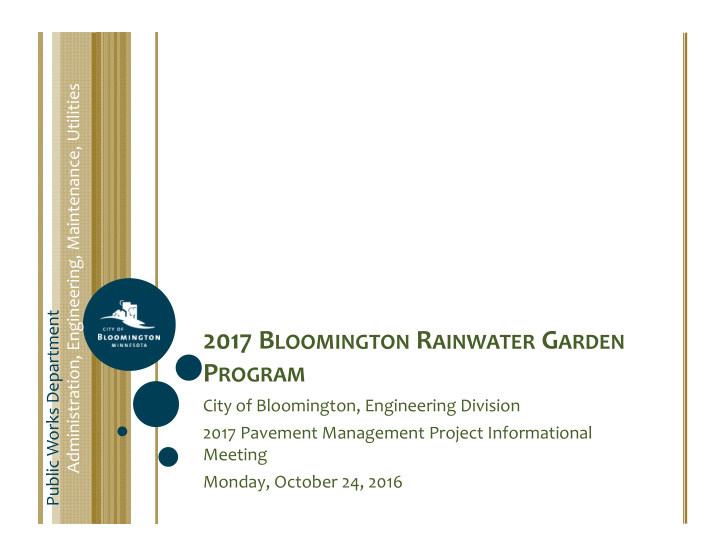



Administration, Engineering, Maintenance, Utilities Public Works Department 2017 B LOOMINGTON R AINWATER G ARDEN P ROGRAM City of Bloomington, Engineering Division 2017 Pavement Management Project Informational Meeting Monday, October 24, 2016
What is a rainwater garden? A rainwater garden is simply a shallow depression dug into the ground designed to capture runoff from rainwater and snowmelt, and infiltrate the water within 24 ‐ 48 hours. Thomas Ave. S., Bloomington , MN (2010)
Why build a rainwater garden? Enhance water quality of receiving waters Reduce runoff volume Promote groundwater recharge Provide habitat for birds, butterflies and pollinators Attractive landscaping feature Bloomington , MN (stormwater bypassing full garden)
Effects of urbanization on stormwater runoff:
Effects of urbanization on stormwater runoff:
Locating rainwater gardens? Gentle sloping yard Good infiltrating soils ‐ sandy No conflicts with underground utilities Rainwater runoff source Enthusiastic gardening ‐ type residents (your participation and long ‐ term maintenance is required) 2010 & 2013 Bloomington , MN
2017 Rainwater Garden Program Neighborhood Knox and Irving Avenues, W 83 rd , W 84 th , W 85 th Streets, Haeg Circle, Haeg Drive, Valentine Terrace, and Irving Curve
What makes up a rainwater garden?
What makes up a rainwater garden? Rainwater runoff source – curb inlet/sediment basin Depressional storage area –12” below curb, sized to capture 1” of runoff, 200 ‐ 300 square feet, gently sloping yard Planting soil mixture – clean compost and sand mix Plants (native and hearty) • Deep rooted grasses, switchgrass, reed grass • Wildflowers, blackeyed susan, cone flowers • Shrubs, winterberry, red twig dogwood Landscape edging to ease mowing, prevent weed intrusion Sediment trap and inlet structure
Rainwater garden maintenance: Pledge to maintain, minimum of ten years Weeding: weekly to monthly during initial establishment; monthly to annually as the garden matures. Divide plants as they grow, 4 ‐ 5 years Cut back dead plant material every spring, plants are good habitat for winter over birds Replenish wood mulch as it decomposes, yearly. Water during establishment period and if experiencing severe drought conditions Remove accumulated sediment, City will clean sediment trap structures in spring and fall
Rainwater garden maintenance: City Maintenance Crews demonstrating Vactor Truck cleaning sediment trap structure
Recent Projects: 2009, Bloomington, Thomas Avenue from W. 106 th Street to W. 108 th Street, six rainwater gardens.
Recent Projects: 2010, Bloomington, Thomas, Upton, Vincent and Washburn Avenues, north of W. Old Shakopee Rd., twenty two rainwater gardens.
Recent Projects: 2013, Russell and Sheridan Ave. S., ten residential rainwater gardens
Recent Projects: 2014, Abbott, Beard, Chowen, Drew and Ewing Avenues S. and Baillif Pl., 22 rainwater gardens
Recent Projects: 2014, Metro Blooms Project , 18 rainwater gardens
What does a rainwater garden look like after a few years? September 2014
What does a rainwater garden look like after a few years? August 2015
What does a rainwater garden look like after a few years? October 2016
Rainwater Garden Education and Resources: City of Bloomington Website, search “rain gardens” or “rainwater gardens” for past projects, Briefing articles, etc. Blue Thumb Guide to Raingardens, available at bookstores, libraries, internet, ~$17 Nine Mile Creek Watershed District website under “Resources”, also source for cost share grant funds Metro Blooms, workshops and website
FAQs: Q: Will my rainwater garden become a mosquito breeding ground? A: No, mosquitoes require 3 to 7 days to transition from the larva to flying insect stages and rainwater gardens should infiltrate in 24 ‐ 48 hours. Q: Will my rainwater garden plug up over time? A: No, infiltration performance should increase as plant roots open up pores in the soil. Sediment should get caught in sediment trap, but if any gets into the garden its best to remove it.
FAQs: Q: How much will this cost? Am I going to be assessed? A: The Rainwater Garden Program is being funded by the Bloomington Stormwater Utility Fund. Individual garden costs are estimated at $3000 ‐ $5000 depending on size and site limitations. No individual assessments for the rainwater garden costs. Bloomington Engineering anticipates up to $25K from the Nine Mile Creek Watershed District in matching funds. Q: What is required of me? A: Labor and commitment, planting, weeding, watering and long ‐ term garden care.
FAQs: Q: Will the pollutants in the stormwater contaminate my plants and ground? A: No, research continues, but the general consensus is that the typical fertilizers, oils, metals and other crud found in residential areas will be filtered out in the mulch, compost and other organic matter, and ultimately will be biodegraded by microorganisms in the soil, especially near the root ‐ zones of the plants.
FAQs: Q: What if I decide I don’t want the rain garden any more? Can I fill the depression and resod? A: You are under no permanent obligation to keep the rainwater garden. This is a completely voluntary program. We anticipate most residents will enjoy it and see it as an amenity. If a resident chooses to remove the rainwater garden, that will be the sole responsibility and at the cost of the homeowner. If you like gardening, this may be fun, if not, please consider that this may not be the program for you.
Questions? Thanks for your time. Website: http://www.BloomingtonMN.gov/ Contact Info: Steven Gurney, PE 952 ‐ 563 ‐ 4606 Email: sgurney@BloomingtonMN.gov
Recommend
More recommend